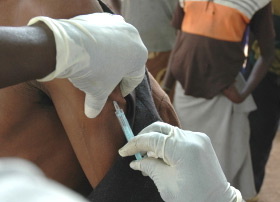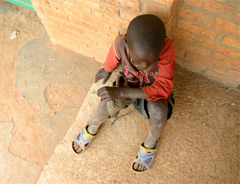|
|
The Scope of the AIDS Pandemic Worldwide
AIDS killed between 2.5 and 3.5 million people worldwide in 2006, including 400,000 children under the age of fifteen.1 Malaria used to be the leading cause of death in the Developing World, killing one million people or more each year.2 However, the total number of AIDS deaths appear to be outstripping even those from malaria. What is more disturbing is that death rates from AIDS continue to increase in every area of the world, except in North America and Western and Central Europe, each year. Even more alarming is the ongoing rise in the number of people becoming infected with HIV. For example, in 2004, the total estimated number of new HIV infections was 3.9 million worldwide; however, in 2006, estimates were at 4.3 million.
In 2006, almost two-thirds (sixty-three percent) of all persons infected with HIV were living in sub-Saharan Africa. This translates into twenty-five million people. An estimated 2.8 million adults and children from this same area became infected with HIV in 2006, more than in all other regions of the world combined. The 2.1 million AIDS deaths in sub-Saharan Africa represent seventy-two percent of global AIDS deaths. An estimated 8.6 million people were living with HIV in Asia in 2006, including the 960,000 individuals who became newly infected in the past year. Approximately 630,000 died from AIDS-related illnesses in 2006. These two regions, sub-Sahara Africa and Asia, represent the areas of the world with the greatest number of people living with AIDS. The total number of people living with HIV in 2006 in all countries was estimated at 39.5 million.3
Reaching Out to Those with AIDS
No matter where we may live, we will eventually find ourselves in contact with or knowing someone who is living with AIDS. Those living in sub-Sahara Africa may be surrounded by friends or relatives who appear to be very sick. However, in many parts of the world, telling friends, family or even fellow church members that you have AIDS puts you at risk for being ostracized. Because of this, many people with AIDS remain silent. We, as Christians, must ask ourselves two questions: (1) How can Christians and the Church recognize this barrier of fear and break it? and (2) What is the basis of this fear and what are some of the social and cultural barriers to be overcome in helping someone with AIDS?![]()
Sometimes it is helpful to simply name the types of fear associated with AIDS. There are many:
- The fear that by associating with someone with AIDS, you will also become infected.
- The fear of being with someone who has a serious illness or who might die.
- The social taboo of what others might think of you if you befriend someone with AIDS.
- The belief that the person who is ill is under God’s judgment or is being punished.
Let us look at these fears. The fear of becoming infected with AIDS is a natural one. The reality is, however, that AIDS is only contagious only under very limited conditions—infected needles, sexual relations, tainted blood transfusions, mother-to-baby birth transmissions or contaminated objects (such as razors or non-sterilized tattooing equipment) that can cut the skin. Eating, drinking, shaking hands or using the same toilet or sink will not transmit the virus to a non-infected person. People with AIDS who suffer from pneumonia, skin infections or other types of secondary infections pose no threat of transmission to a healthy person. The micro-organisms causing these infections are those normally found in air and in the body, but which multiply excessively in the person with AIDS due to his or her deficient immune system.
For some Christians, illness is often viewed as a sign of God’s disfavour or judgment. AIDS crosses the lines of many cultural taboos linked to sexuality, blood and death. As Christians, we have the example of when Jesus faced a similar sickness—leprosy. Leprosy was often regarded as a punishment from God; the sick person was isolated from the rest of the community in the Old Testament (Leviticus 13:45-46). However, Jesus broke this isolation and healed people with leprosy on more than one occasion (Mark 1:40-42; Luke 17:11-14). When Jesus’ disciples asked him if the man born blind suffered from blindness as a result of his sin or his parents’ sin, Jesus answered that neither had sinned (John 9:1-3). Instead, Jesus chose to reach out to him and heal him. Jesus’ compassion for the sick is an example all Christians can choose to imitate.
|
|
A Model of Holistic Evangelism: Ministry to the Person with AIDS
The person with AIDS is often in the prime of life and may have a family and children. He or she is having to face enormous change and stress as he or she deals with the illness. The person sometimes must come to grips with the fact that death is not far away. The Christian ministering to the person with AIDS must also face his or her own fears about death. Contact with a dying person forces us to think about our own death, the fact that we are mortal beings and we also will die one day. There is also the fear of the unknown, since none of us has ever experienced death firsthand.
Additionally, we fear the process of dying and the suffering it might entail. As Christians, our view of death is one of hope because of the life, death and resurrection of Christ. According to 1 Corinthians 15:54, death has been swallowed up by the victory of Jesus’ sacrifice on the cross. Our relationship with God gives us a life with him that cannot be touched or changed by death (Romans 8:38-39). Other scriptural passages for further study include: Psalm 23, Psalm 73:23-26, Romans 8:35-37, 1 Corinthians 15, 1 Thessalonians 4:13-18 and Hebrews 2:9, 14-15.
Pastoral Care to the Person with AIDS
The person with AIDS is experiencing much loss: loss of physical strength and appearance, loss of the ability to work, loss of finances and loss of some social networks. One of the first ways Christians can help is by simply visiting the person at home if he or she is unable to work. We can ask the person questions about him or herself and his or her sickness and frustrations. Our ability to listen, to allow the person to express him or herself freely without judging or giving our opinions or comments, is very important. The person may be angry, depressed or trying to make some sense out of the meaning of his or her life. Listening to the individual very carefully is hard work! However, from our listening, we may begin to discern what God is doing in the person’s life as we seek to bring him or her to faith in Christ (if the person has not already committed his or her life to Christ). ![]()
Here are some questions to ask yourself as you listen:
- What is important, sacred or holy to this person?
- How does this person perceive God’s intentions toward him or herself? Does he or she see God as merciful and loving or angry and vindictive?
- Has this person already had a religious experience that has affected him or her? Was it positive or negative?
- What topics keep returning in the person’s conversation? What are his or her worries and burdens?
The answers to these questions can help us to pray more effectively and may indicate a spiritual door of entry into his or her life. Here are a few ideas to begin to bring God into the person’s world:
- Tell the person you are praying for him or her. Invite others to pray with you.
- Ask the person questions about his or her spiritual reflections. Share with the person your thoughts about God as a living God and one who gives life. People who are dying will be attracted to thoughts about life.
- Offer to read the person comforting psalms or passages of scripture.
- Lend the person praise music, hymns or classical music that can lift his or her spirits and draw him or her to thoughts of God.
- Pray with the person when he or she is afraid or in pain. Talk and pray with him or her over the telephone.
- When the time is right, share your own experience of God and explain how he or she can also experience an eternal relationship with God that will follow him or her after death.
Practical Help
Below are five suggestions for providing practical and needed help:
- Provide practical help with household chores. Prepare a meal or run errands as the person’s illness worsens.
- Provide childcare for parents with young children. This will give the parents time for rest and an opportunity to communicate as a couple.
- Provide material help (food, clothing, money) through the help of your church or group. As the person’s resources are diminished and his or her health worsens, he or she will need this more and more.
- Find other people who can help the person in different ways—housecleaning, writing letters, running errands, etc.
- Provide listening and pastoral care for the person who is ill. On other occasions, provide listening and pastoral care for the spouse or other family members who are the caregivers.
Creating Community Resources as a Church for Holistic Outreach to Those with AIDS
Below are five ways churches can come alongside people with AIDS:
- Create a food or clothing bank through your church.
- Elicit the help of local merchants who can also use their contribution to advertise their business.
- Train pastoral teams who can do home visits to people with AIDS and assess their physical and spiritual needs.
- Create a welcome centre for those with AIDS. Begin a drop-in centre or a community kitchen project to prepare food once a week using the church.
- Create micro-enterprises and co-ops to provide work and income for people with AIDS. These can include photocopy centres, internet services, raising and selling chickens or vegetables, creating handcrafts or painting pictures which can be sold.
![]()
Conclusion
The challenge for the Church continues to grow in light of the number of people who continue to be infected with HIV and contract AIDS. The AIDS pandemic is also an opportunity for Christians to communicate Christ’s love to people in very tangible ways and indirectly, to those who are only observers. May the compassion of Christ give power and initiate ever-increasing works of love in action through Christians around the world.
Endnotes
1. Global Summary of the AIDS Epidemic. United Nations report. December 2006.
2. Centers for Disease Control and Prevention. “Malaria.” 2005.
3. All AIDS data mentioned here can be found at: http://data.unaids.org/pub/EpiReport/2006/02-Global_Summary_2006_EpiUpdate_eng.pdf.


